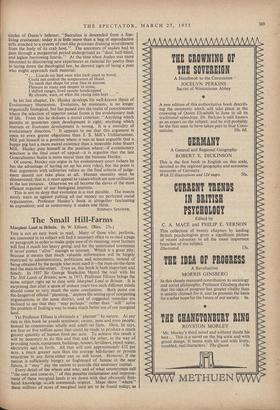The Small Hill-Farms
Marginal Land in Britain. By W. Ellison. (Bles. 25s.) Tins is not an easy book to read. Many of those who, perforce, are interested in its subject will find it necessary often to re-read a page or paragraph in order to make quite sure of its meaning; most farmers will find it much too heavy going; and for the uninitiated townsman it never comes "alive" enough to interest. Which is a great pity; because it means that much valuable information will be largely restricted to administrators, politicians and economists, instead of being obtained by the people who most need it—the man-on-the-farm and the man-in-the-street. Even so, this book is both important and timely. In 1937 Sir George Stapledon blazed the trail with his The Hill Lands of Britain; now, in 1953, Professor Ellison brings the same subject right up to date with Marginal Land in Britain. It is surprising that after a space of sixteen years two such different minds should come to very much the same conclusions. Both point out the dangers of official " planning," deplore the setting up of competing organisations in the same district, and of suggested remedies are inclined to say that they "may perhaps" rather than "will" solve the problem of finding a way to make much better use of our marginal land.
Yet Professor Ellison is obviously a "planner" by nature. At any rate in this book he avoids sentiment, causes, isms and even people; instead he concentrates wholly and solely on facts. Bere, he says, are four or five million acres that could be made to produce a much greater quantity of human food per acre. To achieve this result it will be necessary to do this and that and the other, in the way of providing roads, equipment, buildings, houses, fertilisers, piped water, electricity azid so forth. All that will cost approximately £32 per acre, a much greater sum than the average hill-farmer or private enterprise in any form either can or will invest: However, if the nation is sufficiently hungry or frightened of famine in the near future, it "may" pay the nation to provide this necessary capital.
Every detail of the where and why, and of what countrymen call "the cost and come-to," of this possible reclamation and improve- ment of these marginal lands is set down with that obviously first- hand knowledge which commands respect. Maps show "where" these millions of acres of marginal land are to be found today; as one would expect, most of them are in Wales, the Lake District and the northern half of Scotland. Exactly "why" they are marginal, in other words their historical background, is carefully explained; and this explanation contains one thing that very few people would either have known or expected. Most of the farms in these marginal areas are small, and, if anything, tend to become smaller.
This obviously brings the doubt whether agriculture can ever provide a satisfactory solution to this problem. For one thing, better farming is impracticable while the land is still farmed in what might be termed penny packets. For another, the claims of forestry seem to be so ,much stronger than those of farming. In 1949 the production front hill-farming areas was "about 8 lb. of mutton and 1.9 lb. of wool annually per acre in England and Wales, with lower figures for Scotland, In contrast a conservative estimate of coni- ferous timber production is I k tons of air-dry timber per acre per
annum." • Therefore, most readers will agree that, even if forestry and sheep- farming could and should thrive side by side, the one providing shelter for the animals and the other grazing fire-breaks between woodlands, this can only be achieved in very large holdings, better districts. The present state of things, whereby small hill-farmers have been compelled to produce milk in order to gain a bare living, with lorries collecting little drops here and there by travelling over well-nigh impossible roads, is absurd, and must soon give way to either large-scale farming or forestry. The question is, of course, who is to finance either or both. Private enterprise shows no sign of any desire to do it, which is ominous. Recollection of ground-nuts and other State farming enterprises overseas cannot make many taxpayers anxious for any more of their money to be risked in like fashion. Consequently, here one farmer registers his appreciation of such an honest informative book; but admits that after reading it he shares the author's doubts concerning the value of any grandiose expenditure on the marginal lands of



















































 Previous page
Previous page